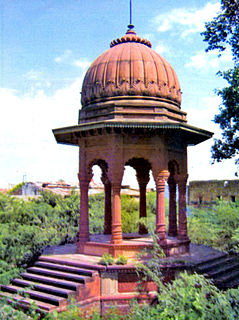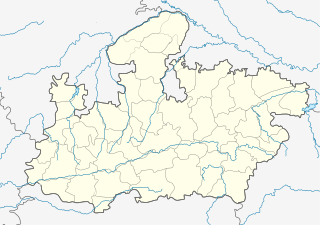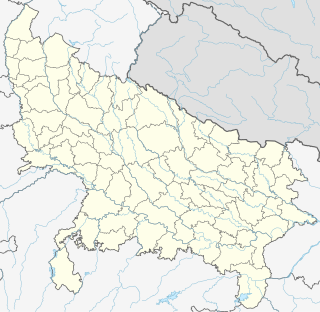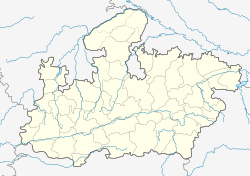
Chhatris, are elevated, dome-shaped pavilions used as an element in Indian architecture. The word Chhatri means "canopy" or "umbrella." In the context of architecture, the word is used to refer to two different things. The usual and more widely understood meaning is of a memorial, usually very ornate, built over the site where the funeral (cremation) of an important personage was performed. Such memorials usually consist of a platform girded by a set of ornate pillars which hold up a stone canopy. The word chhatri is also used to refer to the small pavilions that mark the corners and roof of the entrance of a major building. These pavilions are purely decorative and have no utility, but are a classic folly displaying the status and wealth of the owner.
Maharaja Bhim Singh Rana was the most powerful ruler of princely state Gohad in northwestern Madhya Pradesh, India. According to Alexander Cunningham and William Crooke, Bamraulia gotra Jats from village Bamrauli in 1505 founded the city Gohad near Gwalior. Singhandev was the founder of Gohad state. Later it developed into an important Jat State. The Jat rulers of Gohad were awarded the title of Rana.

Bhind District is a district of Madhya Pradesh state in central India of Chambal division. The town of Bhind is the district headquarters. Bhind District is situated in Chambal region in the northwest of the state. The geographical coordinates of the district are Latitude 26°36' N and Longitude 78°46' E. It is bounded by Agra, Etawah, Jalaun and Jhansi districts of Uttar Pradesh state to the north and the east, and the Madhya Pradesh districts of Datia to the south, Gwalior to the southwest, and Morena to the west. The geography of the district is characterized by uneven ravines, plain fertile fields and scanty forests. The total area of the district is 4,459 km².

Dholpur State or Dhaulpur State was a kingdom of eastern Rajasthan, India, which was founded in AD 1806 by a Hindu Jat Rana Kirat Singh of Dhaulpur, Ruler. After 1818 the state was placed under the authority of British India's Rajputana Agency. The Ranas ruled the state until the independence of India in 1947, when the kingdom was merged with the Union of India.
Maharaja Chhatar Singh Rana was the ruler of Gohad Jat state in Madhya Pradesh, India. He became the ruler of Gohad after the fall of Bhim Singh Rana. Rana Bhim Singh had no son. Afterwards, for a short period, Girdhar Pratap Singh became his successor in 1755. Girdhar Pratap Singh could not rule Gohad for long as he died in 1757. His successor was Rana Chhatr Singh a brave Jat from Bamraulia dynasty a Suryavanshi lineage, claiming descent from Sun, the Hindu god. [4] He ruled Gohad state till 1804.
Girdhar Pratap Singh Rana was the ruler of Gohad Jat state in Madhya Pradesh, India. He became the ruler of Gohad after the fall of Bhim Singh Rana. Rana Bhim Singh had no son. Girdhar Pratap Singh became his successor in 1755. Girdhar Pratap Singh was son of Samant Rao Balju, a family friend of Rana Bhim Singh. Girdhar Pratap Singh could not rule Gohad for long as he died in 1757. His successor was Rana Chhatar Singh (1757–1785). He was from Bamraulia gotra of Jats. He ruled Gohad state till 1757.
Kirat Singh Rana or Rana Kirat Singh was the last Jat ruler of Gohad state (1803-1805) in Madhya Pradesh, India. He was the first Jat Rana ruler of Dholpur. He was from Bamraulia gotra of Jats.
Rana Pohap Singh was the Jat ruler of Dholpur state in (1836) in Rajasthan, India. He was from Bamraulia gotra of Jats. He was elder son of Rana Kirat Singh and his successor. He ruled for nine months and died in 1836. After his death his younger brother Rana Bhagwant Singh ascended to the throne.
Maharana Bhagwant Singh, GCSI was the Jat ruler of Dholpur state in Rajasthan, India. He was from Bamraulia gotra of Jats. He was younger son of Rana Kirat Singh and successor of Rana Pohap Singh. After the death of Rana Pohap Singh his younger brother Rana Bhagwant Singh ascended to the throne.
Maharana Nihal Singh, was the Jat ruler of Dholpur state (1873–1901) in Rajasthan, India. He was from Bamraulia gotra of Jats. He was born on 4 May 1863 as son of Kulender Singh and succeeded Rana Bhagwant Singh on 9 February 1873 after his death. He was of 11 years of age when ascended to the throne in 1873.
Rana Ram Singh, KCIE was the Jat ruler of Dholpur state (1901–1911) in Rajasthan, India. He was from Bamraulia gotra of Jats. He was born on 26 May 1883 and succeeded Rana Nihal Singh in 1901 after his death. He was not of age when ascended to the throne. He got full rights in March 1905.

Karwas is a village in Bhind district in Madhya Pradesh. It was the site of an important fort of Gohad Rana Jat rulers. The ancestor of Bamraulis Jagdeo Singh had come from Agra and stayed at Bhind which was ruled by Aniruddh Singh Bhadauria.The Rana Jats kept their capital at Pach'hara for some time and later shifted the capital to Gohad. The brother of Gohad ruler Jagdeo Singh constructed a fort here in samvat 1680.

Guhisar is a village in Bhind district in Madhya Pradesh. Guhisar is Founded by Jat raja chattar singh rana it is located at a distance of 30 km from Gwalior city in east direction on Bilara Road. Guhīsar is geographically located at Latitude and Longitude 26° 14' 28" North, 78° 32' 43" East. The Scots.

Utila is a village and a fort in Gwalior district in Madhya Pradesh, India. Utila is 20 kilometres (12 mi) east of Gwalior city on Gwalior–Hastinapur-Behat Road.

Bilheti is a village in Gwalior district in Madhya Pradesh. Bilheti is located at a distance of 20 km from Gwalior city in east direction on Gwalior-Chitaura Road.

Makhori is a village in Bhind district in Madhya Pradesh. Makhori is located at a distance of 2 km from Guhisar in east direction on Gwalior-Baragaon-Bilara Road.

Magrora is a town in Gwalior district in Madhya Pradesh. It is situated at a distance of about 5 km from Dabra town, on Gwalior-Jhansi Road, in Gwalior district.
Tewatia (तेवतिया) Tevathiya (तेवथिया) Tiwathia, Tevathi (तेवथि)/(तेवाथी) Tevathiya (तेवठिया) Tewatia (तेवतिया) Tewatia is a clan found in Haryana, Rajasthan and Western Uttar Pradesh in India.









